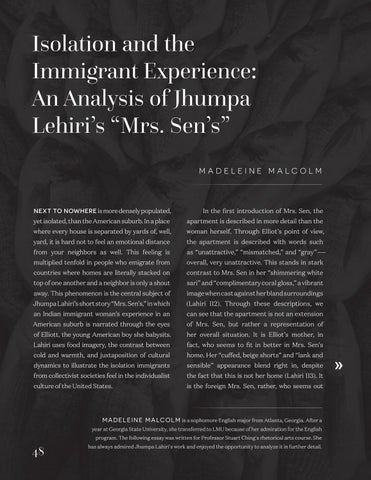Isolation and the Immigrant Experience: An Analysis of Jhumpa Lehiri’s “Mrs. Sen’s” MADELEINE MALCOLM
NEXT TO NOWHERE is more densely populated,
In the first introduction of Mrs. Sen, the
yet isolated, than the American suburb. In a place
apartment is described in more detail than the
where every house is separated by yards of, well,
woman herself. Through Elliot’s point of view,
yard, it is hard not to feel an emotional distance
the apartment is described with words such
from your neighbors as well. This feeling is
as “unattractive,” “mismatched,” and “gray”—
multiplied tenfold in people who emigrate from
overall, very unattractive. This stands in stark
countries where homes are literally stacked on
contrast to Mrs. Sen in her “shimmering white
top of one another and a neighbor is only a shout
sari” and “complimentary coral gloss,” a vibrant
away. This phenomenon is the central subject of
image when cast against her bland surroundings
Jhumpa Lahiri’s short story “Mrs. Sen’s,” in which
(Lahiri 112). Through these descriptions, we
an Indian immigrant woman’s experience in an
can see that the apartment is not an extension
American suburb is narrated through the eyes
of Mrs. Sen, but rather a representation of
of Elliott, the young American boy she babysits.
her overall situation. It is Elliot’s mother, in
Lahiri uses food imagery, the contrast between
fact, who seems to fit in better in Mrs. Sen’s
cold and warmth, and juxtaposition of cultural
home. Her “cuffed, beige shorts” and “lank and
dynamics to illustrate the isolation immigrants
sensible” appearance blend right in, despite
from collectivist societies feel in the individualist
the fact that this is not her home (Lahiri 113). It
culture of the United States.
is the foreign Mrs. Sen, rather, who seems out
M A D E L E I N E M A LC O L M is a sophomore English major from Atlanta, Georgia. After a year at Georgia State University, she transferred to LMU because of her admiration for the English program. The following essay was written for Professor Stuart Ching's rhetorical arts course. She
48
has always admired Jhumpa Lahiri's work and enjoyed the opportunity to analyze it in further detail.
»











